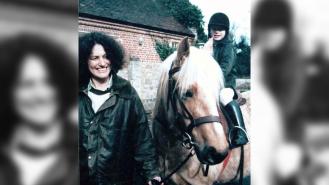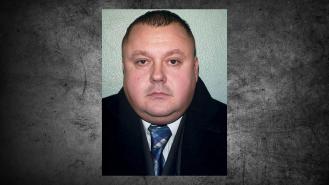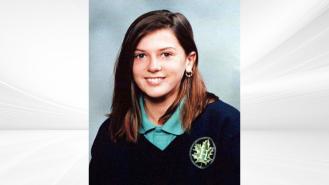
On 9 July 1996, three bodies were found in a little leafy copse beside a country lane in Chillenden, Kent.Dr Lin Russell, 45, and her two daughters, Megan, six and Josie, nine, had all suffered brutal head injuries caused by a blunt instrument. They had been tied up and their family dog, Lucy, was also found dead nearby.
The head injuries were so bad that Lin’s husband and the girls’ father, Dr Shaun Russell, was initially told that they had all died. Unbelievably, Josie was still alive, albeit barely. She was transferred immediately to King’s College Hospital in London, where she was saved. In years to come, she made an even more miraculous recovery.
The three Russells had been returning on foot from a swimming gala at about 4:20pm along the country lane, when a car passed them. Josie even recalled waving to the driver in the car. As they walked further down the lane, the car was parked across the track, and its driver, a man, got out of the car with a hammer. He demanded money from them. Lin had left her money and purse at home but offered to go back to the house with him to get him the money, which he refused. She then told Josie to run to the nearest house to get help.
The man grabbed Josie and hit her on the head with a hammer but inflicted only a slight injury. He then walked the three of them and the dog off the track into a dense copse, where he tied them up with strips torn from Josie’s blue swimming towel, a bootlace and a pair of tights. He then hit Lin on the head at least 15 times, causing severe head trauma and killing her. Josie’s skull was smashed; brain tissue was protruding from a wound behind her left ear and there were several lacerations to her skull. There was extensive tearing to the covering of her brain. Megan had been hit at least seven times, suffering massive skull fractures with exposed brain tissue.
The attacker then got into his car and drove back along the way he had come. About half an hour after the murders had taken place, a man was spotted a mile away from the murder scene in an agitated state. The string bag containing bloodied towel strips was dropped in a hedgerow and the man then left the vicinity.

The Investigation
Over the course of the next year, pressure mounted on the police to find the perpetrator of the brutal murders. They interviewed 9,000 people, took 1,000 statements, and identified a number of suspects. One person was arrested but was later released without charge.
Josie and her father Shaun had moved from Kent to start a new life in North Wales in December 1996. Her injuries left her with speech problems, and she had little to no memory of the attack. On 1st May 1997, she had recovered enough to give an interview to the police. However, leads were unpromising or non-existent.
On 6th February 2022, more than 25 years after the murders, notorious killer Levi Bellfield allegedly admitted to the attack. Michael Stone's lawyers received a written statement that included details about what he was wearing and how he made his escape.
Bellfield is currently serving a life sentence for murdering a 13-year-old girl in 2002, and has also been found guilty of another murder and attempted murder.
A missing shoelace was found in police storage in 2020 that could provide important DNA evidence and link Bellfied to the scene of the Russell attack.
The Key Figures
Victims
Dr Lin Russell, 45, deceased
Megan Russell, 6, deceased
Josie Russell, 9, injured
Accused
Michael Stone
Levi Bellfield
Law Enforcement
DCI Dave Stevens
Lawyers
Nigel Sweeney QC - Prosecution
William Clegg QC - Defence
Read more:
Was Levi Bellfield responsible for the murders of Lin and Megan Russell?
Timeline
June 1960 - Michael John Goodban is born in Tonbridge, Kent.
July 1997 - Stone arrested after he appears on Crimewatch UK.
October 1998 - Stone goes on trial for the murders of Lin and Megan Russell, and the attempted murder of Josie Russell.
October 1998 - Stone is found guilty on all three counts by a 10-2 majority.
October 1998 - Stone is given three life sentences.
November 1998 - Stone’s defence team lodge an application to appeal based on the admission of perjury by a key prosecution witness.
January 2001 - Stone is granted the right to appeal.
February 2001 - Stone is successful in his appeal.
February 2001 - The judges quash his conviction but order a retrial.
September 2001 - Stone’s retrial begins at Nottingham Crown Court.
January 2005 - Appeal lodged.
January 2005 – Appeal dismissed.
December 2006 - High Court judge imposes the highest tariff he is legally entitled to impose, and it will be 25 years minimum before Stone will be eligible to be considered for parole.
February 2022 - Notorious serial killer Levi Bellfield claimed to be responsible for the attack, according to Stone's solicitors.
The Trial
At first instance, the prosecution’s case rested on three main planks. Firstly, a number of sightings by local witnesses; secondly, forensic evidence tying him to the scene of the crime; and thirdly, three "confessions" made by Stone to prison inmates whilst detained and awaiting trial.
The first plank saw varying descriptions of the man they saw that afternoon. At 4:30 pm, Isobel Cole saw a clean-shaven man of medium build wearing a dark blue baseball cap and carrying a hammer. Half an hour later, Anthony Rayfield saw a beige car, parked with the boot open. The man standing next to the car was small, light-haired and wiry, aged 35 to 40, and appeared agitated. Nicola Burchill saw a beige car at 4:45 pm, its driver was round-faced with chubby cheeks.
Pauline Wilkinson saw two men near the murder scene; one had short blonde hair, while the other had darker hair. Josie herself recalled that the car was brown or red, clean and driven by a single man. He was blonde, clean-shaven, about 25-years-old and the same height as her father, around 6 feet. Stone is 5’7” and podgy. He was also 37, his hair was brownish and receding. He had a light beard and he drove a white Toyota.
It is hard to know what to make of the various witness testimonies, save that there can be little reliability placed on them. The second plank was based on forensic evidence found at the scene. The troubling fact was that there was very little of it. Four hairs were taken from beach shoes belonging to Josie; red fibres were found on or around Lin's body, and more red fibres were found on a pair of blue tights used to tie up one of the girls; a bootlace also used to tie the girls was found and there was a single blood-stained fingerprint on their lunchbox. Tests showed that it was not Stone’s fingerprint. None of the fibres or hairs belonged to Stone, nor to members of his family or his acquaintances.
The prosecution argued that the bootlace was a common component of the drug addict’s equipment. It is used as a tourniquet, tied around the arm to raise the veins for intravenous injection of heroin. It is pulled tight with the teeth, therefore there should have been saliva stains on it. There were saliva stains, however DNA testing showed that they were not Stone’s.
The final, and crucial, plank of the prosecution’s case rested on testimony by Stone’s associate, Lawrence Calder, Calder’s girlfriend Sheree Batt, and three supposed confessions to various inmates.
Calder, a regular drug user and habitual criminal, alleged that Stone had turned up at his house the day after the Russell murders at around 10:30am. Stone was driving his white Toyota and had “spots of blood down the front (of his t-shirt) and a large area of blood on the groin”.
Calder's testimony disintegrated under cross-examination. He was hopelessly confused about dates; he could not even remember which month it was that Stone came to their house. Batt then took the stand and contradicted her boyfriend’s testimony. She said that Stone had come to their house two or three weeks before 24th July 1996 (the murders were committed on 9 July 1996), and she only remembered a few spots of blood on his t-shirt. These were unconvincing and contradictory testimonies from two unreliable witnesses.
The three confessions were crucial. Mark Jennings had been jailed for life for the murder of a barman. Stone asked Jennings what he thought of the Russell murders and went on to suggest that Jennings should have killed the witnesses in the pub murder. He (Stone) would kill anyone, including women and children, if it would keep him out of jail.
However, this conversation was totally denied by Stone and it later came out in court that Jennings' sister had been paid £5,000 by The Sun, with a promise of a further £10,000 after the trial if Stone was found guilty.
Barry Thompson, serving two years for dishonesty and intimidating a witness, claimed that he and Stone had an argument, and Stone said “I made a mistake with her [Josie]. I won't make the same f***ing mistake with you”.
Damian Daley’s evidence was the most damning. He claimed that he and Stone had communicated by speaking into a heating pipe connecting their two cells. Stone had apparently starting talking about “smashing heads, breaking eggs”, then said, “I would have been OK if it hadn't been for that slag, if that slag hadn't picked me out”.
He mentioned a dog, saying that the dog made more noise than the victims did. Finally, Stone mentioned swimming costumes and that he had been aroused by sniffing the swimming costumes. Even with the lack of forensic evidence or credible witness testimony, the jury returned a guilty sentence, after fifteen hours of deliberation, by a 10-2 majority, on 23rd October 1998. They had been swayed by the supposed confessions by Stone to his fellow prisoners, and the judge gave him three life sentences.
However, a week after the verdict and sentence were handed down, in an interview with The Mirror newspaper, Thompson denied that his conversation with Stone took place. “None of what I said was true and I want to give a statement to his solicitor admitting I lied. Stone never said the words I attributed to him. I told the jury a pack of lies”. Solicitors for Stone immediately lodged an appeal on 6th November 1998.
He was granted the right to appeal on 8th January 2001, and on 6th February 2001, Stone won his challenge at the Court of Appeal. The three Appeals judges allowed the appeal due to the unreliability of the key witness Thompson, who admitted to perjury in a court of law. If a retrial was not ordered, Stone would be set free. Stone’s counsel argued that a retrial would be inherently unfair due to the media publicity it received, “such has been the wealth of prejudicial material adverse to him (Stone) and inadmissible in any criminal trial”. The court quashed Stone’s conviction but ordered a retrial.
On 5th September 2001, Stone’s retrial began at Nottingham Crown Court and on 4th October 2001, Stone was found guilty of the murders of Lin and Megan Russell, and the attempted murder of Josie Russell, again by a 10-2 majority. At this trial, Thompson’s testimony was discredited and Jennings’ evidence was not even used. Counsel for the defendant attempted to bring up Daley’s heavy heroin use as proof of Daley’s unreliability. However, the jury decided to accept Daley’s testimony and returned the guilty verdict. His three life sentences were re-imposed. The defence immediately appealed and in early January 2005 won the right to appeal.
However, on 19th January 2005, his appeal was dismissed. In April 2006, he mounted an unprecedented legal challenge to halt publication of a report into his medical history before the killings, claiming that it represented an infringement of his right to privacy under the European Convention of Human Rights. In England and Wales an independent inquiry is mandatory into any homicide by someone who has had recent psychiatric care.
On 21st December 2006, a High Court judge imposed the longest tariff he was legally entitled to impose on Stone’s life sentence, the maximum 25 years, before he would be eligible to be considered for parole.
The Stone case highlighted several deficiencies in the laws on mental health in the United Kingdom and prompted Parliamentary debate on the Mental Health Bill in 2007, that would amend the Mental Health Act of 1983. Stone had an untreatable personality disorder which had been diagnosed two years before the killings. However, he could not be legally detained because his illness was classified as untreatable. His terrible alleged crime led to calls for powers to detain untreatable cases even if they had committed no crimes.
This would provoke furious opposition from human rights and patients rights groups, who claimed that the Bill, if it became law, would allow the enforced detention of people who are mentally ill, even if they have not committed any crime, and also would mean that great numbers of mentally ill people who refuse medication could find themselves forcibly treated. The House of Lords in particular was in opposition to the Bill and it was of the opinion that it needed more safeguards for patients.
Nonetheless, the Bill became law in 2007 and was implemented on 3rd November 2008. Stone’s trials and convictions also raised serious questions about the appropriate weight that should be given to testimony from unreliable witnesses, as well as the wider question of whether juries were really the best equipped to consider matters of guilt and innocence in the midst of widespread and intense media coverage.
The Arrest
Exactly a year after the murders, on 9th July 1997, the desperate police allowed the case to air on Crimewatch UK, a popular television show that shows reconstructions of hitherto unsolved or ongoing crimes, with the aim of gaining information from the public.
The move seemed to have worked, as the police received a call from a Dr Philip Sugarman, a psychiatrist, who told them about his patient, Michael Stone. Sugarman revealed that Stone had nightmarish fantasies that corresponded to the murders. A week later, Stone, 37, was arrested and held in Canterbury jail. On 6th October 1998, he went on trial for the murders of Lin and Megan Russell and the attempted murder of Josie Russell, at Maidstone Crown Court.




